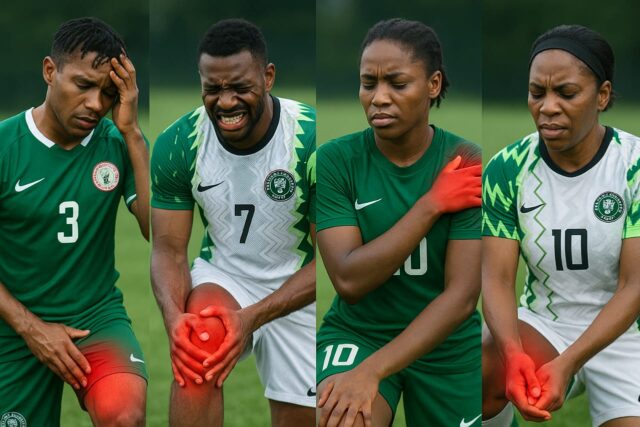Nigerian footballers, from grassroots players to professionals, are frequently exposed to injuries due to the physical nature of the sport, often compounded by environmental and infrastructural challenges.
The most commonly affected areas are the lower limbs, particularly the ankle and knee. Understanding these injuries, their causes, and how to prevent and treat them is crucial for the long-term health and performance of these athletes.
Common Injuries
- Sprains and Strains (Approx. 45.6%)
- Typically occur due to overstretched or torn ligaments and muscles.
- Common in the ankle and hamstring.
- Bruises and Cuts (Approx. 27%)
- Result from tackles, falls, or collisions during games.
- Concussions (Approx. 15.2%)
- Caused by head impacts from falls, headers, or accidental elbows.
- Anterior Cruciate Ligament (ACL) Injuries
- Common in elite players, often requiring surgery and lengthy rehabilitation.
- Causes
- High-Contact Play: Tackles and physical duels frequently lead to trauma injuries.
- Poor Pitch Conditions: Uneven or unmaintained pitches increase the risk of ankle and knee injuries.
- Inadequate Warm-up: Lack of proper stretching or warm-up exercises makes muscles more prone to strain.
- Improper Footwear: Wearing the wrong type of boots or poorly fitted shoes can affect movement and increase injury risk.
- Overtraining: Excessive or repetitive training without rest can cause fatigue and lead to overuse injuries.
Prevention Strategies
- Structured Warm-up and Cool-down Routines
- Incorporate dynamic stretching, light jogging, and mobility drills before games.
- Use of Protective Gear
- Shin guards and proper footwear can reduce contact-related injuries.
- Regular Pitch Maintenance
- Ensuring flat, debris-free fields minimizes falls and missteps.
- Player Education
- Teaching safe playing techniques and body mechanics, especially at youth levels.
- Strength and Conditioning
- Regular gym-based training can strengthen muscles around joints and reduce vulnerability.
- Treatment Options
- Immediate Care (RICE Method)
- Rest, Ice, Compression, and Elevation are key within the first 24–72 hours of injury.
- Physiotherapy
- Critical for recovery, especially for ligament or muscle injuries. It restores mobility, strength, and balance.
- Medication
- NSAIDs (non-steroidal anti-inflammatory drugs) can reduce pain and inflammation.
- Surgical Intervention
- In severe cases like ACL tears or fractures, surgery may be required.
- Rehabilitation and Gradual Return to Play
- Return should be monitored to avoid recurrence. Reconditioning is key.
- Conclusion
Football injuries are an inevitable part of the sport, but with the right preventive measures, awareness, and treatment strategies, Nigerian players can significantly reduce their risks. Investing in proper facilities, coaching education, and health support systems will go a long way in improving player welfare and performance on the pitch..
For enquires/Consultation
Call- Dr kolade kolapo
+234-7032088130









